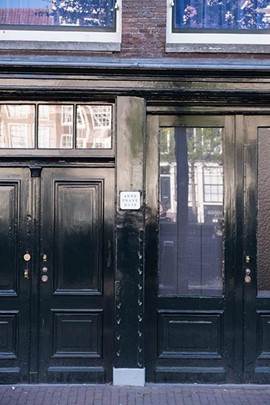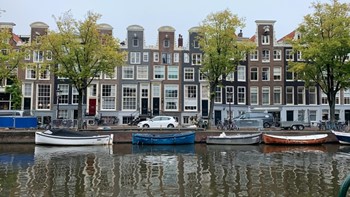
Sights and sounds of the Prinsengracht
3 September 2021
The Prinsengracht, named after the Prince of Orange, is one of the four main canals in the Amsterdam canal belt, which were added to the UNESCO World Heritage List in August 2010. The canal is 3.2 kilometres long and runs parallel to the Keizersgracht. Construction of the Prinsengracht started in 1612, during a time when the city grew exponentially. The canal is crossed by 14 bridges, is home to a LOVERS Canal Cruises dock and offers plenty of sights and sounds to enjoy.
Anne Frank House
Our dock on the Prinsengracht is right next to the Anne Frank House, the former house and hiding place of the world famous, Jewish wartime diarist Anne Frank. It is the 3rd most visited museum in the Netherlands and a must see when you are in Amsterdam. It was here where Anne Frank and several other people were in hiding in a secret annex during World War II, as they hoped to survive the war.
The current entrance to the museum is just off the canal, facing the market and Westertoren, but the door to Prinsengracht 263, the original house, can be seen from the water. In 1955 the building was almost demolished, as there was an intention to build a factory in its location but a campaign to save the building and list it as a protected building was successful. The building was first opened as a museum in 1960.
Noorderkerk
Further north along the canal, lies the Noorderkerk (Northern Church) in the Jordaan district of the city. This Protestant church was build in the early 17th century and designed by Hendrick de Keyser, who also designed the Westerkerk and Zuiderkerk. The Noorderkerk has a symmetrical, cross-shaped layout, reflecting the ideals of the Renaissance and Protestantism. The church’s unique design combines an octagonal floor plan with a structure shaped like a Greek cross, with four arms of equal length, and a small tower in the centre of the cross.
The Noorderkerk sits on the Noordermarkt square, which also features a cosy and colourful market. There has been a market here since the 17th century, it started as a pots, pans and patch market, but today it offers plenty for the modern consumer. On Monday mornings and on Saturdays, the range of offerings here is quite unique, with antiques and curiosities, books and prints, special textiles, glass and crockery, jewellery of your own design, vintage clothing, paintings and graphics, bags made of recycled canvas and so on.
Notable gables
The gabled canal houses in Amsterdam’s Canal Belt are some of the city’s most picture perfect features. You can find several types of gables along the Prinsengracht. For instance, on the corner with the Brouwersgracht, you can spot a crow-stepped gable at Prinsengracht 2-4, which is a stairstep type of design at the top of a triangular gable-end building.
Over at Prinsengracht 300 you can see the perfect example of a clock gable, the building’s nickname is the red fox as there are two on the building. One above the door and the other above the top window in the gable. Meanwhile Prinsengracht 833-839 feature identical neck gables and Prinsengracht 556 offers a typical example of a 19th century so-called Ojief spout façade.
Westertoren
Just a stones throw away from the Anne Frank House stands the largest Protestant church in the Netherlands, the Westerkerk (Western Church). Unlike the Noorderkerk, which had the same designer, the Westerkerk has a more traditional basilica design, with the form of two Greek crosses connected with each other, also known as a patriarchal cross. Famous Dutch painter Rembrandt van Rijn is buried in the church, though the exact location is unknown.
The tower of the church, known as the Westertoren is the highest church tower in Amsterdam, at 87 meters, and can be seen from some distance even in the densely populated city of Amsterdam. The tower is topped with the Imperial Crown of Austria of Maximilian I.
Just above the clock-faces on the tower, sits the carillon, which has 51 bells. It is the only carillon in the city to chime all twenty four hours, as well as every half hour and even a short tune at the quarter of the hour. And every Tuesday at noon, the city’s carillonneur gives a one hour recital which can be heard far and wide.
Prinsengracht Concert
Every August, since 1981, the Prinsengracht features a free, open-air concert of classical music. The orchestra takes its place on a pontoon anchored in front of the Hotel Pulitzer and the canal fills with the boats of the audience. Traditionally the concert end with a rendition of “Aan de Amsterdamse grachten” one of the city’s unofficial anthems.
Since 1988, the concert has been part of the Grachtenfestival, though it is still independently organised. The Grachtenfestival is a ten-day festival spread out across the city, featuring classical music, jazz and music from other cultures.


